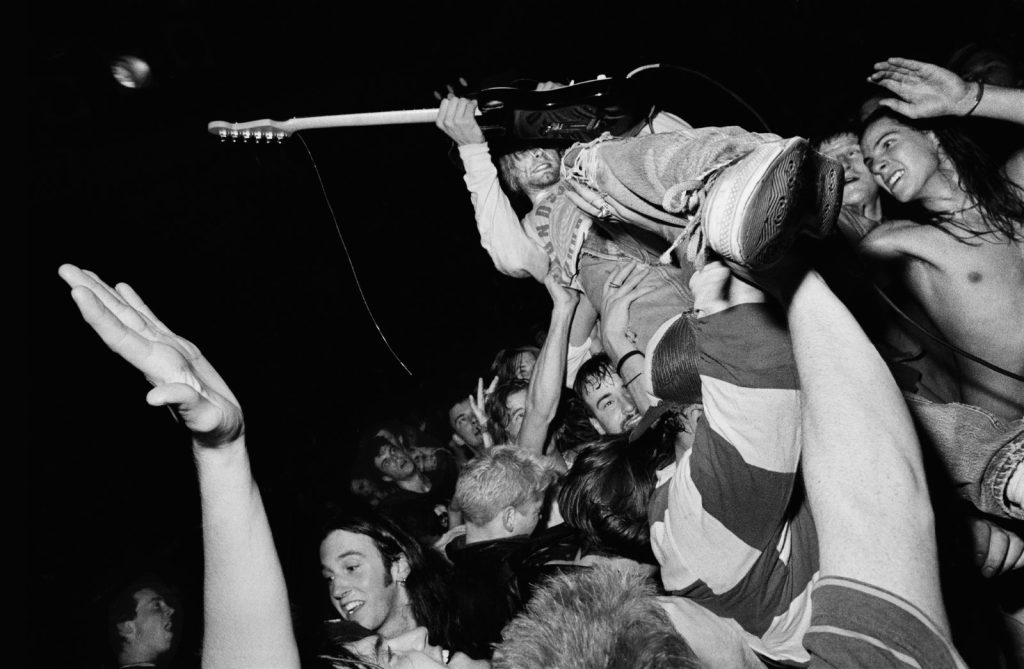Nirvana Exhibition promotes individuality and passion through iconic photographs of the band
Nirvana Exhibition reflects on historic photography by Charles Peterson while creating space for young artists and outcasts to emerge.
Dive into the immersive and explosive world of “Charles Peterson’s Nirvana: On Photography and Performance” exhibition at the Tacoma Art Museum (TAM). The exhibition, which premiered on Oct. 5, reveals several iconic shots and moments during the peak of the band’s rise to fame.
Peterson is known for his memorable organic photographs that capture the heart and spirit of the 90s Grunge scene in the Pacific Northwest.
From gelatin silver pigments to hazy euphoric shots of Nirvana’s bass player Krist Novoselic, this exhibition offers a wide range of images to experience. Curator of the exhibition Michelle Dunn Marsh explains how the idea came to fruition and why Charles is such a significant part of the band’s public image through photography.
This interview dives into Charles Peterson and Dunn Marsh’s collaboration as well as reflecting on new paths for young artists and creators today to emerge.

Q. Thank you so much for doing this interview. Can you please introduce yourself to people who may not know you?
A. My name is Michelle Dunn Marsh. I am the publisher and co-founder of Minor Matters Books. We published Charles Peterson’s Nirvana as a book in February this year.
Q. What is Minors Matters Books?
A. Minors Matters Books is a collaborative publisher that started here in the Pacific Northwest. It’s been around for eleven years and develops artbooks with artist authors. We see the images and sizes of the artwork and then put it out to the public for typically 3 months. It we can secure three hundred to four hundred presales of those books then we publish it and all the people who purchased it will be credited within the book. Charles’s book hit the presale minimum within a few hours back in May 2023.
Q. Are these never-before-seen photographs?
A. Many of these photographs have been published. There’s about a third that has not been published. (Charles had three previous books but none of them focused on a single band. I’ve known him for a very long time and he’s a friend and a photographer who I’ve really respected.
I asked him “why do you want to work with us?” Dunn Marsh says. “You’ve already worked with major publishers.” He responded, “I want an artbook. Not a music book, not a fan book and I know that’s what you will do.”
Q. Did he take that famous baby photograph of the 1991 Nevermind album?
A. No, he didn’t. His photograph is on the second edition of Bleach (1989) I believe, which was Nirvana’s first album with Sub Pop records. All the photos in the exhibition are in black and white. When it came to the exhibition, I really wanted to highlight him [Charles] as the subject and to draw attention to what is unique about his photographs.
I included six other non-music photographers to the exhibition to really reflect what Charles work is all about. Paul Berger was Charles’ professor when he was at the University of Washington. Some of his photographs which will be shown at the exhibit help capture the distinct visual elements and experience of Charles work.
Q. How would you describe Charles photographs in the exhibition?
A. The word that kept coming up to me is agitated. When you’re working in a dark room and you’re making a print, you shake the film when it’s developing. That’s called agitation. It’s a strong sense of movement throughout Charles’ work and some of that is related to how he shot pictures. He shot on film but had an off-camera flash. He was essentially painting with light. Charles is also a huge fan of the music and would be dancing or moving around when he was taking them. As a result, the photographs carry a lot of that same movement at that moment in time.
Q. The photographs almost look as if he is jumping up and down when he captures these moments as they’re moving.
A. Yes, there’s blur in the photographs and streaks of light. In particular, there’s one photograph of the bass player Krist Novoselic I absolutely love. He’s front and center in front of a crowd during a performance when Charles snaps a photo of him. But because Charles was moving while the flash was moving, it looks like a double exposure even though it’s not. You just see the shadow of Krist looking down while the actual figure is looking right at you. It’s an extraordinary photograph to look at.
Q. His photographs really capture that time. Do you think people today will relate to the content? Will it just be older fans who come to the exhibition?
A. I hope that people who are interested in their music, or the eighties or are from this region come by. This is a regional art museum and it’s an amazing opportunity for us to be at home and be able to celebrate people who came from here. I think it’s really relevant that photography was an important component to the rest of the world understanding that this look went with this sound.
People like Charles really gave a face to that sound. When Charles book came out, it was incredible to see that fans had a real love for Charles photographs. It was not simply six degrees of separation to celebrity or to the bands. They appreciated his photographs for many years, and it felt significant to them.
A huge part of the curation [of the photos] is what does it mean to be from the Northwest. Charles is from here, as am I and the band Nirvana. Thinking about our childhood from the seventies and eighties and how often we were left alone to do whatever we were doing is very different from today.
Q. Did the band have any shows in Tacoma?
A. They did. Kurt lived in Tacoma for a while with his girlfriend and I think that Krist and his girlfriend also lived here. That band in particular is a South end story. They were in Aberdeen, Montesano and Olympia. They were not a Seattle band and didn’t start there. I grew up in Puyallup and Charles grew up in Bothell. For all of us, being an outsider was a point of connection.
Nobody expected Nirvana to go big. Giving the space and opportunity for those individuals he photographed was big. Honoring those points of origin.
Q. Can you tell me more about the photographs at the exhibition?
A. Charles printed out a little over twenty photographs for this exhibition. There are also gelatin silver prints. Gelatin silver prints are how we printed photographs before the digital world. There will be a fake “dark room” in the exhibition that people can view.
There will be a sink with trays and an enlarger for people to better visualize how these prints were made. Charles had varied studios over the years. When he went to the University of Washington, he had a dark room where he would do his work.
Q. Were there any challenges in creating this exhibition and making it come to life?
A. There have been exhibitions of Charles work in Europe and another one in the United States on the East coast. They tend to make very giant prints on the walls and highlight this frenzy. I didn’t want that.
I wanted them to be thought of as jewels and precious objects that you stand in front of spend time with like any other type of work. You have to think through on every level the size of the prints, the sequence and how they would appear within the space. It’s a very paired down experience. I love that people are gonna walk into a giant gallery and only see black and white photographs.
Q. Is this an exclusive exhibition for Tacoma?
A. It is. We hope that it will go to other parts of the United States. It’s been designed to travel so we hope that there will be other institutions that will take it. Charles’s work has been on display at the Museum of Pop Culture for a long time.
Q. What are you hoping that people will take away from this?
A. First and foremost, appreciation for photography is an artform. Photography is definitely the language of the day. Everyone is making, sharing and posting pictures but not always thinking that they are speaking through visual images. I want every young person to walk in there and believe that their dreams can come true.
I didn’t think that I was gonna end up publishing books and I’m pretty sure that Charles didn’t think that he was gonna end up having a solo museum exhibition. And I’m fairly sure Nirvana didn’t think that they were gonna get out of the garages they were performing in. That part really matters to me the most in Tacoma and Fife and Puyallup.
Q. Do you think that it’s gotten easier for someone like Charles or the band members of Nirvana to go after their dreams or has it gotten harder?
A. In certain ways some things are easier and in some ways things are harder. When we look at a world that is so deeply connected yet there is such an increase in loneliness. People feel disconnected from each other and don’t feel a sense of community. I hope that being in a space and interacting with visual material will bring a sense of connection.
Finding your tribe, people or community is both always hard and always easy. You have to care about something and then find the people who also care about that. The part that’s exciting about being in college is that it’s an opportunity to learn and discover new things. For me, learning photography was an artform, it kind of took over my whole life.
I hope that any exhibition fosters questions from people like how do I do this? What does it mean to be here? How can I get here? I love those questions. This whole thing doesn’t feel real to me even though I’ve been working on it for the past nine months. I’m just a kid from Puyallup and I ask myself, how did I get here?

For more information about this exhibition or purchase tickets, please visit the TAM website: https://www.tacomaartmuseum.org/exhibit/charles-petersons-nirvana/
The exhibition will remain at TAM until May 25, 2025.



